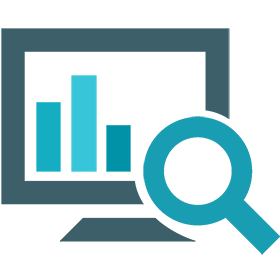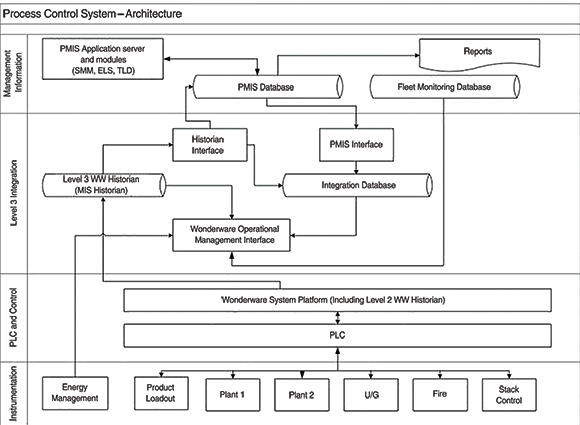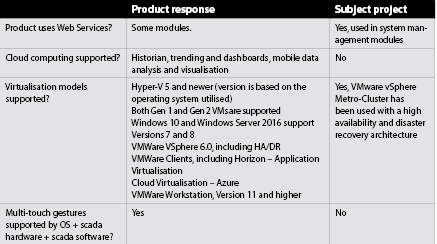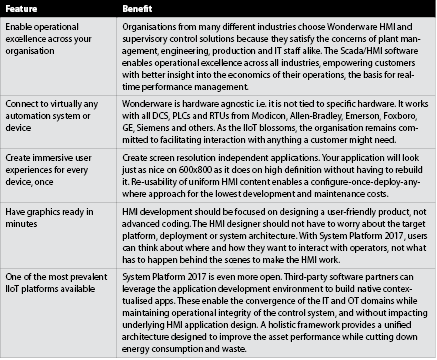

End-user details
Name: Jaco van Heerden
Designation: Project C&I Engineer
Company: African Rainbow Minerals Limited
Phone: +27 (0)11 518 4199
email: jaco.vanheerden@arm.co.za
SI details
Name: Johann Pienaar
Designation: Director
Company: Iritron
Phone: +27 (0)12 349 2919
E-mail: johann.pienaar@iritron.co.za
Product details
Product name and version: Wonderware System Platform and InTouch Operations Management Interface (OMI)
Vendor: Wonderware Southern Africa: Distributor of AVEVA Software
Phone: +27 (0)11 607 8100
E-mail: johann.pienaar@iritron.co.za
URL: johann.pienaar@iritron.co.za
Application details
Location: Black Rock Mine Operations. Black Rock, Northern Cape, South Africa
Industry: Mining
Project start date: 2015-06
Project end date: 2018-02
Application: Central Control Room which included video wall
Server OS: Windows Server 2012 R2 Client OS: Windows 8.1 Enterprise
Application statistics
Tag count: 14 886 Instances; 325 Templates
Updates per day: 90 979 200
Disk space for one day’s updates: 580 Mb
Physical I/O count: 41 693 I/O; 34 743 History Tags
Front ends: OPC, Modicon PLCs, SQL
Licences: VMWare vSphere 6 Enterprise Plus for Virtual Servers SupCl ReadOnly w/HistClient2017 MSCAL for 5 off Wonderware Intouch OMI Wonderware System Platform 2017 Update 1 for Level 3 integration layer VEEAM Availability Suite
Scada configuration man-hours: 3500 man-hours (CCR SCADA) 800 man-hours (Video Wall)

End-user responses
General
Q: Briefly describe the application including information on any pre-existing control system.
Driven by a 10-metre video wall in a centrally controlled environment, this innovative project provides both mine management and the operational team with an integrated and situationally aware dashboard. This enables enhanced decision making, and the ability to recognise opportunities and address challenges proactively. It is supported by core services such as power, network and data centre infrastructure to ensure business availability, continuity and effective data recoverability.
The central control room was designed and equipped with a strong emphasis on corporate branding and ownership. High availability of the services provided was an essential component of the overall design. Existing legacy infrastructure and systems had to be considered in the migration process from a highly fragmented environment to a single consolidated platform.
The road to modernisation consisted of multiple enablers in the pursuit of excellence, which included the following world-class technology components:
• Enhanced networking provides a mesh of critical connectivity between the modern datacentres. The new network design is an essential enabler towards completing the vision as it allows for the backbone to connect the multitude of services and to act in unity.
• The processing platform provides the performance required for the business processes and servers. The existing storage layer was moved from spinning disk to SSD technology, which brought about considerable performance enhancements and optimised space utilisation.
• The complete new environment was duplicated at the second datacentre, creating a mirror image. The extended cluster established a single, logical, Metro-Cluster Datacentre. This modernised single-cluster design allows for business availability scenarios that have never before been possible. The design allows for a complete datacentre site failure to be recovered at its counterpart, and be 100% operational and functional within minutes.
• The virtualisation technology in place was upgraded, and various next-generation software components were applied.
• The video wall solution is a first for South Africa and illustrates the efficient use of the latest in visualisation technologies.
Q: What was the primary motivation for the project?
Modern-day technology has to support modern-day business requirements.
Digital solutions must be able to react to and sustain the demands and pressure from business. This can only achieved by utilising modern-day strategies and empowerment of people, closely aligned with the required business outcomes.
Once this vision was aligned with the business outcomes, each respective process was broken down into its elements, and so the evolution of the central control room at the Black Rock Mine Operations began. Black Rock Mine Operations, operated by Assmang Limited, is in the Northern Cape Province of South Africa, approximately 80 kilometres north-west of the town of Kuruman. Assmang Limited is jointly owned by African Rainbow Minerals Limited and Assore Limited.
The continuous pursuit of excellence, as suggested, is an ongoing effort to modernise, automate, streamline and continuously improve on all aspects of the business. This application is regarded as the start of many new opportunities in the future of digital transformation at the Black Rock Mine Operations. It provides an indispensable tool to keep costs low, profits high, and decisions strategic.
Q: What were the main goals established for the project?
1. A migration process from a highly fragmented environment to a single consolidated environment.
2. High availability and business continuity of the services provided in the control room was an essential component of the overall design.
3. To integrate various sources of information ranging from automation, MIS, electrical, fire detection, and power and asset management systems to provide a holistic view of the entire value chain of the mine operation to the operational staff. This, in turn, provides the necessary tools to enhance real-time decision making. It gives the right information to the right people at the right time with the least amount of effort.
Q: What project management principles and/or methodologies did you employ as end-user to mitigate risk, ensuring the project came out on time and within budget?
Followed the Guide to the Project Management Body of Knowledge (PMBOK Guide), 5th Edition.
We planned to succeed by determining the as-is state of the brownfields environment, defining the user requirements and business objectives, developing a process control strategy and supporting specifications. Intense scheduling and planning sessions were held with the relevant parties to minimise the impact on production activities and where possible utilised technology and infrastructure as interim solutions for the migration process. Planning comprised at least 2/3 of the project duration.
Licensing, maintenance and support
Q: Do you have a documented process in place to manage, test and install OS and scada system software patches?
Yes, ARM Strategy for Process Control Systems.
• The version upgrades are done in a virtual environment hosting a set of virtual servers.
• The virtual servers represent all servers as found on site in the runtime environment.
• Virtual machine software installation is dedicated for the following functions: Galaxy Repository Servers; Historian Servers; Information Servers; plus a number of Redundant Application Server pairs and a Remote Desktop Server.
• All Virtual Machine Environments are equipped with snapshot or roll back capability.
• The virtual environment must be completely isolated from the runtime environment.
• Refer to Implementing Wonderware System Platform in a Virtual Environment Implementation Guide [DS08], for guidelines on how to apply an upgraded system.
• Test the full functionality of the upgraded version.
• When tests are successfully completed, servers will be moved from the test environment to the runtime environment.
Integration, reporting and archiving
Q: Is the system integrated with an MES / ERP or other management reporting or control system (e.g. Baan, SAP, SYSPRO…)?
Yes, Minesuite using .NET interfaces.
Q: Has any asset management functionality been configured in the application (for software assets, control system assets or for plant assets)?
Yes, underground fleet monitoring using Datatrap interfaced with the system database and presented on the video wall as KPIs.
Q: Do you run the scada in conjunction with any third-party application software (Other than expert system, AC, AR, MES, GIS or asset management system)?
Yes, ecWin Power Monitoring System and the Sperosense CO Monitoring System.
Q: Does the application include data archiving/historian capabilities with an historical data reporting system?
The application uses WW Historian for both the automation and integration layers. The integration layer historises contextualised data while the automation layer historises all raw production related data. Both WW Historians are used in conjunction with the MIS for reporting requirements.
Maintenance, reliability and asset optimisation
Q: Have any operational or production benchmarking tools been configured as part of the scada system?
Yes, a 10-metre video wall in a centrally controlled environment. This provides both mine management and the operational team with an integrated and situationally aware dashboard, enabling enhanced decision making, and the ability to recognise opportunities and address challenges proactively. The end goal of this was to integrate various sources of information ranging from automation, MIS, electrical, fire detection, and power and asset management systems to provide a holistic view of the entire value chain of the mine’s operations.
Q: What maintenance, reliability or asset optimisation criteria relating to this system and the plant were included in the user requirements specification for this project?
High availability design on both the datacentre and network levels and to provide opportunities for upgrades and maintenance on the system infrastructure (and associated systems) without interruption to production.
End-user conclusion
Q: What was the predominant feature (or features) that made you decide to purchase this scada product over all others for this application?
The product provides the ability to ensure that the automation layer is aligned with the business objectives, is an extension of the current installed base, and supports future growth requirements.
Q: What was the most significant change that you implemented in scada engineering practice/technology in this project?
The video wall displaying the complete value chain with integrated KPIs and situationally-aware principles to inform operations, engineering and mining personnel.
Q: What single operational feature most impresses you about the product now that it is in operation?
Provides a platform to align the automation layer with business objectives, and by integrating with the various systems provides a base for ‘One version of the Truth’, which in turn empowers the operators to make informed and in-time decisions.
Q: What impresses you most about the architecture?
Hardware architecture ensures business continuity via high availability and provides opportunities for upgrades and maintenance on the system infrastructure and associated systems without disruptions to production.
Software architecture provides, by means of the integration layers, a platform to align the automation layer with business objectives.
SI Responses
Project details
Q: What tools were used to minimise the man hours taken?
1DES System Platform and Modicon Export Utilities, WSP Import/Export Utilities.
Q: What human factors were taken into consideration as principles or development standards in the HMI design process?
Situational awareness principles were applied according to Wonderware best practices and First-up alarming.
Q: For the graphics development process did you use standard library images, or did you have to draw images from scratch?
Both standard graphics library objects, as well as newly developed Intouch OMI objects, were used.
Q: How would you describe the library of graphic images?
The standard library of objects is comprehensive and only user-specific objects had to be developed.
Q: What alarm management standards or best practices were adopted in configuring the scada system alarms?
WW Alarming Best Practises were implemented. ARM Process Control Strategy.
Q: What structured processes were followed to determine expected performance under full load, and during abnormal failure conditions (such as network interruptions, node failures, power outages, controller failures, etc.)?
During commissioning of the systems, numerous worst-case failure tests were performed i.e. datacentre crashes, network failures, power failures, MES failures, etc.
Q: What levels of redundancy are incorporated in this scada application?
WSP AOS fail-over, Data-Centre High Availability fail-over between duplicate data-centres, network redundancy on all networks. Administration, Plant, Control and Device level. Redundant Power supplies (UPS and Powers switches).
Maintenance, reliability and asset optimisation
Q: In engineering this project, what steps were taken to address maintenance, reliability, asset optimisation and/or continuous improvement aspects relating to this system and the plant monitored/controlled by this system?
All control systems were implemented according to the BRMO SCADA/PLC specification and the approved project FDS. The ARM Process Control Strategy was used as guideline. Legacy standalone control systems were migrated into WSP and into the new virtual environment. All control systems were FAT tested extensively against 3rd party simulations before being commissioned on site. Environmental monitoring, HVAC monitoring, Fire monitoring, CO monitoring, Power monitoring and Network monitoring was implemented to alarm any failures in the central control room. The end-client technical staff were actively involved in all stages of the project for effective knowledge transfer, to ensure efficient future maintenance and enhancements.
Security and data protection
Q: In what ways is this project’s hardware architecture optimised for patch and antivirus management?
1. Due to the fact that the control system is running in a virtual environment all patching can be implemented and tested on a cloned test environment before being deployed on the live system.
2. Anti-virus management is fully integrated into the client’s anti-virus system.
Q: What configuration backup and data archive backup methodologies have been adopted?
A comprehensive off-site VEAAM backup and disaster recovery solution was implemented.
SI conclusion
Q: How would you rate the ease of use of the historical reporting system?
Very easy to use.
Q: What impresses you the most about the engineering/configuration aspects of the product now that it is in operation?
The maintainability and stability of the systems.
Q: What impresses you most about the architecture?
The architecture is very scalable on all levels.
Vendor responses
Product
Q: Vendor comments on product/modules?
Wonderware System Platform and Operations Management Interface (OMI) provide the tools to establish a common information and control infrastructure across many geographically dispersed assets and systems. This enables users to have a view of their entire value chain to make sure that they can run and react efficiently to changing conditions.
System Platform is a complete automation solution that can deliver 40% efficiency gains in the face of changing business and market demands by eliminating the need for scripting or customisation, and leveraging reusable visualisations.
System Platform 2017 is the only responsive, scalable platform for supervisory, scada, MES and IIoT applications, which integrates the process with the Enterprise. System Platform provides a collaborative, standards-based foundation that unifies people, processes and assets for continuous operational improvement and real-time decision support.
Licensing, maintenance and support model
Q: What sort of licensing agreement options are offered?
Users can choose which modules to buy and how many of each to implement, and in addition the number of users that need access to the system.
Perpetual and/or subscription based licensing offered per module. This allows customers to decide if Capex and/or Opex is used to fund the system.
Q: Are licences sold outright or subject to periodic (e.g. annual) renewal?
Perpetual and/or subscription based licensing offered per module. This allows customers to decide if Capex and/or Opex is used to fund the system e.g. licence is a once-off purchase, or, licence is a once-off purchase for a particular version, or, licence requires annual renewal.
Technology incorporated

Q: What changes have been introduced into the product in the last 12 months?
1. InTouch OMI NextGen Visualisation Client.
2. Responsive HMI Framework (layouts/panes) means build once.
3. Object Wizards enable visual standards deployment.
4. Complete ready-to-use automation library.
5. Multi-Touch & Gestures – the magic touch.
6. Powering the ‘app’ revolution and digital transformation.
7. Auto-build your project and auto-generate standards.
8. Model-based smart navigation.
Integration and reporting
Q: What generic and/or product specific interfaces does the product have iro well-known MES packages?
The Wonderware suite has proven integration to all ERP and MES systems as it supports all the open integration protocols and system specific protocols unique to MES and ERP vendors. In addition, Wonderware provides toolkits that allows users to create custom interfaces if required.
Q: What native historical data reporting options are available?
Wonderware Historian comes with its own built-in reporting and dashboard tool – InSight. This can further be extended to a cloud-based solution that can provide information wherever users are. Open SQL interfaces and OData, web services are also supported that allows any third-party reporting tool to be used with the Wonderware Historian. This includes, MS Reporting Services, PowerBI, Tableua, etc. In addition, Insight provides some unique capabilities:
• Smart watches including Apple Watch, Android Wear compatible devices.
• Mobile phones such as iPhone, Android.
• Tablets and phablets (aka super-sized phones like the Samsung Galaxy Note).
• Desktop PCs and laptops via any modern HTML5 browser including Chrome, Safari, Edge, and IE11.
• Large screen displays like a projector screen or HDMI TV (driven by a smart browser, projected mobile devices (e.g., iOS AirPlay or mirroring software), and including Microsoft Xbox One).
Maintenance, reliability and asset optimisation
Q: What maintenance, reliability, asset optimisation and/or continuous improvement related modules or capabilities does the product incorporate relating to the IT and/or control system of which this product forms a part and/or the plant monitored/controlled by such system?
The system provides a complete APM (asset performance management) suite, including:
1. Preventive maintenance.
2. Condition-based maintenance.
3. Predictive maintenance.
4. Risk-based maintenance.
5. Prescriptive maintenance.
6. Mobile workforce enablement.
7. Monitoring and diagnostic services.
8. APM assessment.
Unique selling proposition (USP)
Q: List the top five feature/benefit pairs that contribute to this product’s USP.

© Technews Publishing (Pty) Ltd | All Rights Reserved